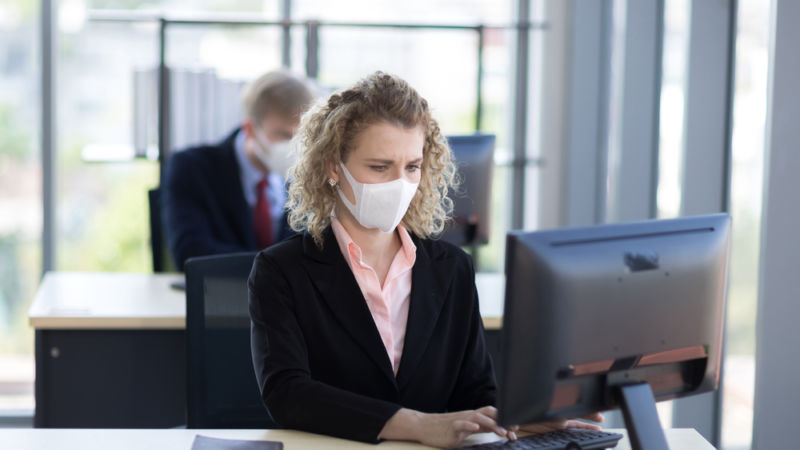In our new blog series, "Using Your Platform for Good", Irene Liu, General Counsel of Checkr, discusses how to make stronger workplaces during this crisis
The current public health crisis has been challenging in many ways, but I am optimistic that workplaces will come out of the crisis stronger, with increased capability and agility.
In fact, difficult periods like this can bring people together to support and stand together, albeit virtually. And amid the COVID-19 pandemic, I’ve seen more companies provide greater flexibility around workplace norms and more leaders showing humanity and vulnerability in the workplace.
This crisis has also led to increased transparency from company leaders as they navigate an unknown path. It’s now easier than ever to distinguish which companies truly have the heart and economic backbone to survive.
So, what should organizations do to survive and exit this crisis stronger than ever?
Preserving employee engagement
To foster a strong workplace during this crisis, companies need to boost their communication at all levels of the organization to help employees stay connected and engaged. For example, Checkr has increased its all-hands meetings from once to twice a week. And many leaders have taken their daily, in-person “standup” team meetings at the beginning of the day for alignment of work activities into the virtual environment without a hitch.
I’ve also continued our team meetings once per week and my one-on-one meetings with each of my direct reports virtually. During our virtual weekly team meetings, I give everyone an opportunity to speak and share their weekend or social update to foster “hallway” conversations. I have also allowed the lulls in the conversation to naturally occur without feeling like I need to step in and fill in the awkward pauses. These lulls or pauses give space for others to create social chatter and banter. We also offer optional virtual happy hours weekly on a Friday to close out the week and discuss our plans for the weekend.
Such social interactions preserve our team culture and employee engagement during this crisis, and will also pay off when we return to the office with our team culture intact.
Flexing on when work gets done
Because many workers have found themselves fulfilling work and family responsibilities at the same time while quarantined, managers need to allow employees the autonomy to determine when their work gets done. As a mother of two boys, I too am experiencing the challenges of juggling work and home-schooling myself. As a leader, the most important role I can play for my team is leading by example and messaging on the need to be flexible on when work gets done.
In response, my peers and I give people the freedom they need to handle both work and family roles by making clear that we’re not so concerned what time of day the work gets done. The key outcome is that the work gets done, and each employee can determine when it is completed. And a big part of this is messaging is that it’s okay to block off time on your calendar for family commitments, take days off for personal well-being or even ask for help if a project cannot get done. I am also encouraging my team members to take paid leave to give themselves mental breaks wherever possible, especially since some tend to use this time to over-work from waking hours to late evenings, accelerating their burn-out.
I also know that some people may be challenged by juggling the demands of both work and family and the lack of boundaries between work and home that have transpired as the result of the public health crisis. In these situations, empathy, flexibility and accommodation are so important, and as a leader and manager, I attune myself to the needs of my team members and adapt my role as manager and coach, by listening and providing support.
Expanding ‘new normal’ conditions post-COVID-19
Once most of the mandates around shelter-in-place end, and things slowly start to return to normal, the workplace is likely to experience permanent changes regarding expectations around agile working and workplace flexibility for employees.
Given that remote work will be normalized through this crisis, companies should start planning for supporting more remote work in the future. Organizations that once were skeptical about productivity in a work-from-home environment will now see first-hand how their employees’ productivity can be maintained even at home, and should start offering greater work-from-home flexibility. That will allow employees who choose to work from home continued work-life integration.
Companies also need to plan for the “new normal” office environment that requires both social and physical distancing and prepare their workforce for this “new normal.” Some employees will appreciate the privacy and reduced distractions because of six feet of distance between desks, cubicles, and work-spaces, especially in open floor plans. For others who love being around people, it will take time to adapt as it will no longer provide as close a connection to other employees. And employees will all need to adapt to new ways of saying hello to each other. How will they greet each other without shaking hands or giving hugs? Will they be replaced by elbow bumps, nods, or even bows?
Short-term, creating this “new normal” office environment can be challenging and potentially costly. But long term, the “new normal” will allow organizations to experience greater efficiency and cost savings. Companies will ultimately need less office space and workstations because roles that were previously required to be done full-time from the office now can be delivered remotely in some capacity.
Staying connected
The need for physical distance — and therefore, working in the new normal — is likely to remain for a prolonged period of time. So, staying connected is ever more important.
For law firms, I’d advise partners to check in more often with your clients and prospects. Lead with humanity by asking clients how they are doing with the new normal of working and use this opportunity to develop an increased personal connection with clients and prospects.
For me, keeping up connections to outside counsel and my GC peers has been and will continue to be a priority. My networks of GC peers have also been a huge help, offering a platform of support in addressing new legal and compliance questions, ranging from work-from-home stipends to emergency leave ordinances that have arisen out of the crisis. These peer networks have been a tremendous way to quickly obtain guidance and benchmark options on legal situations. So even during the shelter-in-place, continue to foster your connection to these networks through virtual happy hours and meetings.
Silver lining
Out of the hardships this crisis has produced, I have observed small silver linings that make me optimistic about workplaces coming out of this situation stronger. I see more humanity and less compartmentalization between work and family life, mostly out of necessity.
Indeed, it is not uncommon to have small children’s needs being addressed in the middle of work meetings. Having these little voices sonically in the background has been a welcome addition to our meetings and has reminded me what is truly important. So, while we cannot plan for the post-COVID-19 world, let’s embrace this time that we have to spend with our loved ones and turn each day into a good one both at work and at home.






